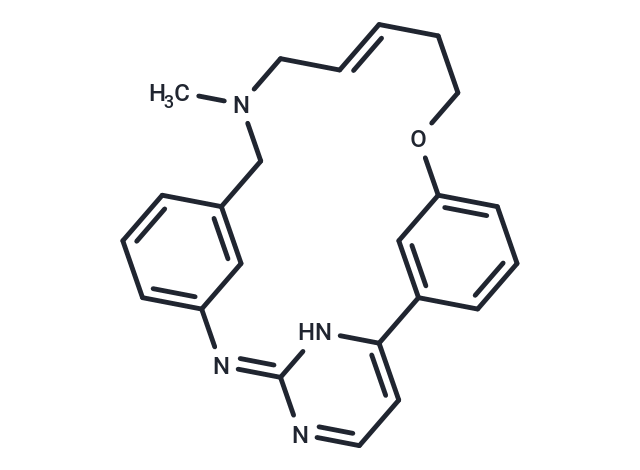Shopping Cart
Remove All Your shopping cart is currently empty
Your shopping cart is currently empty
SB1317 (TG02) is a potent inhibitor of cyclin dependant kinases (CDKs), Janus kinase 2 (JAK2), and Fms-like tyrosine kinase-3 (FLT3).

| Pack Size | Price | USA Warehouse | Global Warehouse | Quantity |
|---|---|---|---|---|
| 2 mg | $30 | - | In Stock | |
| 5 mg | $48 | - | In Stock | |
| 10 mg | $83 | - | In Stock | |
| 25 mg | $166 | - | In Stock | |
| 50 mg | $283 | - | In Stock | |
| 100 mg | $485 | - | In Stock | |
| 200 mg | $693 | - | In Stock |
| Description | SB1317 (TG02) is a potent inhibitor of cyclin dependant kinases (CDKs), Janus kinase 2 (JAK2), and Fms-like tyrosine kinase-3 (FLT3). |
| In vitro | SB1317 has a highly novel kinase inhibitory spectrum inhibiting 17 kinases from a panel of 63, 11 of which are CDK/JAK/FLT family members. The others, Lck, Fyn, Fms, TYRO3, ERK5, and p38δ, are implicated in inflammatory and proliferative processes. Human CYP1A2, 3A4, 2C9, and 2C19 isoforms are not inhibited by SB1317 at the highest tested concentration of 25 μM, but SB1317 inhibits CYP2D6 with IC50=0.95 μM, approximately at the plasma Cmax observed at the maximum tolerated dose. SB1317 inhibits cell proliferation concentrations in HCT-116 (IC50=0.079 μM) and HL-60 (IC50=0.059 μM)[1]. SB1317 is a novel small molecule potent CDK/JAK2/FLT3 inhibitor. SB1317 is mainly metabolized by CYP3A4 and CY1A2 in vitro. SB1317 does not inhibit any of the major human CYPs in vitro except CYP2D6 (IC50=1 μM). SB1317 does not significantly induce CYP1A and CYP3A4 in human hepatocytes in vitro[2]. |
| Kinase Assay | The recombinant enzymes (CDK2/cyclin A, JAK2, and FLT3) are used. All assays are carried out in 384-well white microtiter plates using the PKLight assay system. This assay platform is a luminometric assay for the detection of ATP in the reaction using a luciferase-coupled reaction. The compounds are tested at eight concentrations prepared from 3- or 4-fold serial dilution starting at 10 μM. For CDK2/cyclin A assay, the reaction mixture consisted of the following components in 25 μL of assay buffer (50 mM Hepes, pH 7.5, 10 mM MgCl2, 5 mM MnCl2, 5 mM BGP, 1 mM DTT, 0.1 mM sodium orthovanadate), 1.4 μg/mL of CDK2/cyclin A complex, 0.5 μM RbING substrate, and 0.5 μM ATP. The mixture is incubated at room temperature for 2 h. Then 13 μL of PKLight ATP detection reagent is added and the mixture is incubated for 10 min. Luminescence signals are detected on a multilabel plate reader. The analytical software Prism 5.0 is used to generate IC50 values from the data[1]. |
| Cell Research | SB1317 is prepared in DMSO and stored, and then diluted with appropriate medium before use[1]. All cell lines are obtained from the American Type Culture Collection and cultured. For proliferation assays in 96-well plates, 20 000 cells are seeded in 100 μL of medium and treated the following day with compounds (e.g., SB1317 ) (in triplicate) at concentrations up to 10 μM for 48 h. Cell viability is monitored using the CellTiter-96 Aqueous One solution cell proliferation assay. Dose-response curves are plotted to determine IC50 values for the compounds using the XL-fit software[1]. |
| Synonyms | TG02 |
| Molecular Weight | 372.46 |
| Formula | C23H24N4O |
| Cas No. | 1204918-72-8 |
| Smiles | CN1C\C=C\CCOc2cccc(c2)C2=CC=N\C(N2)=N\c2cccc(C1)c2 |
| Relative Density. | no data available |
| Storage | store at low temperature | Powder: -20°C for 3 years | In solvent: -80°C for 1 year | Shipping with blue ice/Shipping at ambient temperature. | ||||||||||||||||||||
| Solubility Information | DMSO: 10 mM, Sonication is recommended. | ||||||||||||||||||||
| In Vivo Formulation | 10% DMSO+40% PEG300+5% Tween 80+45% Saline: 2 mg/mL (5.37 mM), Sonication is recommended. Please add the solvents sequentially, clarifying the solution as much as possible before adding the next one. Dissolve by heating and/or sonication if necessary. Working solution is recommended to be prepared and used immediately. The formulation provided above is for reference purposes only. In vivo formulations may vary and should be modified based on specific experimental conditions. | ||||||||||||||||||||
Solution Preparation Table | |||||||||||||||||||||
DMSO
| |||||||||||||||||||||
| Size | Quantity | Unit Price | Amount | Operation |
|---|

Copyright © 2015-2025 TargetMol Chemicals Inc. All Rights Reserved.